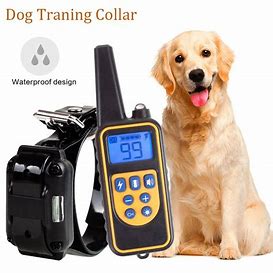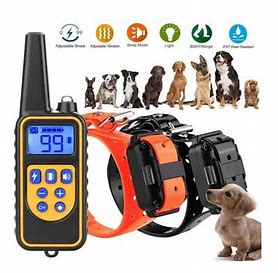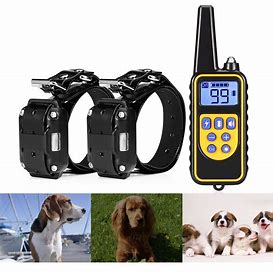800m Range: This specification indicates the maximum distance over which the remote control can communicate with the collar. It allows you to issue commands and corrections to your dog from a considerable distance.
Electric Stimulation: These collars often include an electric stimulation feature, which can deliver various levels of static stimulation (also known as static shock or e-stim) to the dog when they misbehave. It’s important to use this feature carefully and responsibly, ensuring it doesn’t cause harm or undue stress to the dog.
Remote Control: The collar comes with a remote control device that allows you to send signals to the collar. You can use it to deliver commands, issue corrections, or trigger other features like vibration or sound.
Waterproof: The collar is designed to be waterproof, which means it can withstand exposure to moisture and rain. This feature is essential for dogs that may come into contact with water during training sessions or outdoor activities.
Multiple Modes: Some training collars offer multiple modes, such as vibration and sound, in addition to electric stimulation. These alternative modes can be less aversive and may be suitable for some dogs.
Adjustable Stimulation Levels: Many modern training collars allow you to adjust the intensity of the electric stimulation. This customization is essential to ensure that the correction is appropriate for your dog’s size and temperament.
Rechargeable Batteries: Both the collar and the remote control are typically equipped with rechargeable batteries. This is more cost-effective and environmentally friendly compared to disposable batteries.
Safety Features: Responsible training collar designs include safety features like auto shut-off mechanisms to prevent overstimulation and injury to the dog.
It’s important to note that while electric dog training collars can be effective tools for training and behavior management, they should be used with caution and following appropriate training guidelines. Always consult with a professional dog trainer or veterinarian before using such a collar, especially if you are new to dog training or have a particularly sensitive or reactive dog. Training should be done with care and a focus on positive reinforcement methods whenever possible.
Training Purposes: Electric collars should primarily be used for training and behavior modification, not as a punishment tool. They can be helpful in teaching commands, discouraging unwanted behaviors, and reinforcing boundaries.
Consult a Professional: Before using an electric collar, it’s highly recommended to consult with a professional dog trainer who has experience with this tool. They can provide guidance on proper usage and techniques that suit your dog’s specific needs.
Start with Low Stimulation: Begin training with the lowest stimulation level that your dog can perceive. Gradually increase the intensity only if necessary and under the guidance of a professional.
Positive Reinforcement: Whenever possible, combine the use of the electric collar with positive reinforcement techniques. Reward your dog with treats, praise, or toys when they respond correctly to your commands or stop an undesirable behavior.
Consistency: Be consistent in your training methods. Use clear and consistent commands and signals so that your dog can understand what you expect from them.
Timing: Correct your dog’s behavior immediately after they perform an unwanted action or fail to obey a command. Timely correction helps the dog associate the correction with their behavior.
Avoid Overuse: Do not rely solely on the electric collar for training. It should be just one part of a comprehensive training program. Overusing the collar can lead to desensitization or stress in your dog.
Monitoring: Always monitor your dog when they wear the collar, especially if they are left unsupervised. Check for any signs of irritation or discomfort, such as skin redness or excessive scratching.
Training Sessions: Keep training sessions short and positive. Long, repetitive sessions can be stressful for the dog. End on a positive note with a successful command or behavior.
Safety First: Ensure that the collar fits properly, with enough room for two fingers to fit between the collar and your dog’s neck. This prevents it from being too tight or causing discomfort.
Use Responsibly: Electric collars should not be used as a substitute for proper care and attention. They should not be used to address issues caused by neglect, lack of exercise, or medical conditions.
Compliance with Local Laws: Be aware of any local or regional laws or regulations regarding the use of electric collars on dogs. In some areas, their use may be restricted or regulated.
Training Environments: Start training in a quiet, low-distraction environment. Gradually progress to more distracting locations as your dog becomes more proficient with commands.
Avoid Fear or Anxiety: Never use the electric collar to instill fear or anxiety in your dog. It should be a tool to help with training, not a source of distress.
Regular Checks: Periodically check the contact points on the collar to ensure they are clean and making good contact with your dog’s skin. Cleanliness is important for effective stimulation.












Reviews
There are no reviews yet.